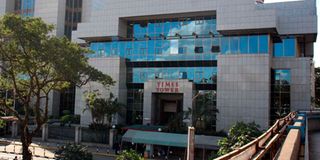It could be a bright sunny day, marking a nation’s triumph and economic resurgence, or, on the other extreme, an Eastern Sunset Scenario, depicting an unfavourable environment marked by an ineffective state. It could also be something in between — a Jua Kali Kingdom or the Managed Economic Stagnation. Economists and social scientists have worked out four scenarios that will be influenced by the actions the country takes today.
Kenya 2040: A Nation’s Triumph and Economic Resurgence
Sarah wakes up on August 9, 2040, to the nostalgic sound of a child's bicycle bell and a newspaper thudding against her front door.
The headline, 'Kenya still number one!', proudly announces Kenya's fifth straight year as Africa's top performer in the UN's Human Development Index.
The strides made during the 2030s in poverty reduction, healthcare, and education have transformed Kenya into a global contender, boasting world-class transport infrastructure and one of Africa's most diverse economies.
As Sarah enjoys breakfast, she discovers the conclusion to a corruption case she had been following closely.
Kenya's judiciary, characterised by independence and efficacy, plays a pivotal role in holding public officials accountable.
Corruption cases are swiftly investigated, showcasing a legal system unafraid to sanction those who fail to account for public resources.
As Sarah observes her Brazilian neighbours, she contemplates the realization of the anticipated economic growth in real GDP.
The initial projection foresaw an average annual growth rate exceeding 5 percent for a decade, followed by a subsequent decade with an average annual growth rate surpassing 4 percent reaching Sh22.7 trillion, with GDP per capita surpassing $6,000.
This robust economic performance has successfully attracted expatriates from various parts of the world to engage with the thriving Kenyan economy.
Kenya's business landscape has evolved, with both local and foreign companies competing in sectors once reserved for state monopolies.
The Nairobi Securities Exchange (NSE) thrives, solidifying its position as one of Africa's leading stock exchanges, attracting portfolio inflows and foreign investments.

A member of staff at the Nairobi Securities Exchange on the trading floor on 20 September 2019.
Even though Sarah may not be particularly intrigued by portfolio investment, she values the advantages associated with a stable currency.
The exchange rate for shilling is approximately Sh140/$, and the relatively low inflation, as indicated by the Leading Economic Indicators publication at around 4 percent per annum, contributes to this stability.
This economic environment is fostered by a commitment to trade openness and enhanced domestic production.
The resulting stability affords Sarah the luxury of an annual overseas trip, which has become a customary occurrence in her household. Additionally, her daughter's engagement with equity markets mirrors the growing purchasing power of private consumers.

Kenya’s overall balance of payments has fluctuated over the years to stand at a Sh127.8 billion deficit in the first quarter of this year.
Reflecting on family discussions, Sarah notes the absence of debates around public debt and state-owned enterprises as government finances have significantly improved.
Public debt by the end of the first decade was about 75 per cent of GDP but this now stands at about 67 per cent.
Privatisation has eliminated most SOEs, and the remaining ones exhibit improved transparency in reporting.
The full privatisation of Kenya Airways symbolises a shift from State-driven to State-facilitated development, eradicating public debt concerns.

Kenya Airways Boeing 787-8 Dreamliner aircraft.
Unemployment decreases significantly from 27 per cent to 18 per cent, and disposable income per capita rises to $7,742.
Kenya's transition to a private sector-led economy marks a triumph, making Sarah even prouder to call herself Kenyan.
Later, Sarah's brother, a former tax practitioner turned golf coach, highlights the ease with which citizens handle taxes through government e-services platforms, which drove him out of business.
E-government initiatives have streamlined tax administration, and a simplified tax code encourages both individuals and corporations to contribute willingly.
Trust in the government is bolstered by a credible budget process, targeted programmes, and transparent government expenditure, ensuring citizens see tangible results in improved service delivery.
The Kenya Revenue Authority (KRA) consistently meets revenue collection targets, thanks to a large tax base, enabling the government to maintain competitive tax rates globally. Developmental progress and unity form a positive feedback loop. The government relinquishes its patriarchal role, and citizens actively contribute to further development.

Times Tower in Nairobi, the Kenya Revenue Authority headquarters.
Public participation in policy discussions surges, with civil societies and opposition parties systematically included. Elections focus on policy debates, marking Kenya as a lodestar for the continent's progress.
The journey to 2040 is marked by economic prowess, political inclusivity, and a sense of national pride. Kenya stands as a model for the continent, illustrating the tangible benefits of progressive policies, active citizen participation, and a thriving private sector-led growth model.
The Managed Economic Stagnation
For Sarah, it was one of those really thrilling days. Her child was competing in the 2040 National Academic Olympics, a prestigious academic tournament.
It was much grander and more grandiose this year than it had ever been since its debut. It was evidence of her daughter's intelligence just that she was allowed to compete. What's even more thrilling is that her daughter came second overall in the nation.
Sarah finds out that her daughter has been awarded a nice position by the government before she could return home to congratulate her on her excellent achievement in the contest.
The current regime is making a concerted effort to get Kenya's most gifted students to work in its departments, especially in the technology sector. These contests are now used by the government as a hiring ground.
Because of above average salaries, this offers an incentive for young people to work in the public.
Nevertheless, the market provides a balance in supply of jobs both in the private and public sectors. For Sarah's daughter, landing a well-paying job in government is a dream come true.
The quality of services provided by the public lagged for a while compared to those in the private sector.
However, favourable policies allowed for the entry of the public sector into formerly private-dominated industries during the early years after government’s efficient and effective growth.
The government now dominates the transport sector and has interest in the telecommunications market. Not only do they control the major sectors of health and education, but also this. Protectionist policies that elevated State Owned Enterprises (SOEs) and nationalised and monopolised big industries have made it possible for the government to be present and dominate key industries.
Foreign competition has been shut out by poor trade policies like price controls and government intervention in markets. As a result, these regulations have hindered foreign direct investment and prevented private sector from making long-term investments. A severely underdeveloped private sector reflects this.
Other consequences resulted from SOE dominance are strong regulatory policies that have discouraged entrepreneurship and prevented innovation, even from the best talent hired by the government.
Prioritisation of the SOEs has localised the economic environment, reducing the interests of foreign companies and investors.
Due to unfavourable policies, these investors were forced to relocate to neighbouring countries, which now have a competitive advantage over Kenya, which was the top choice for foreign investors.
However, the country's security situation has significantly improved because of the increased state capacity.
The Kenya National Bureau of Statistics (KNBS) has released official data indicating a notable decline in crime rates.
However, with the help of cutting-edge technology, this increased state capacity has resulted in high state surveillance.
People like Sarah are concerned about this over-reaching surveillance because they believe the negative effects outweigh the positive ones. In addition, this excessive surveillance violates the right to privacy guaranteed by the Constitution.
It is significant to remember that this enormous state machinery is not cost-effective. For the past 20 years, budget financing has experienced huge surpluses that have grown every other year.
For example, the surplus increased to 12 per cent of GDP from 4 per cent a decade ago. Economics experts have repeatedly cautioned that these trends carry significant risks in the medium and long terms, in addition to being unsustainable in the long run.
At high tax rates, the struggling and contracting private sector is unable to remit to the government targeted revenues, leaving the government with no choice but to borrow more money, which sharply increases its share of public debt as a share of GDP. The public debt has risen from 65 percent of GDP to 92 percent in just 10 years.
Furthermore, the excessive government borrowing has crowded out the private sector. This is because lenders prefer lending to government because it is less risky.
Consequently, the Small, Micro and Medium Enterprises (SMEs) have been affected disproportionately. Some now cannot access the financial resources to expand while others are closing down due to stiff competition from the SOEs, which enjoy subsidies.
Kenya is believed to be the safest country in the region, and official statistics support this view. The government now employs many people that are paid above average salaries; the healthcare system appears to be serving the needs of the public; and the education system is a source of national pride.
However, freedom of speech and privacy have been a trade-off for increased security. A closed economy controlled by the state has come at the expense of the crucial private sector and a globally integrated economy.
Sarah is left wondering: Is the nation moving towards the dystopia outlined in George Orwell's classic novel Nineteen Eighty-Four, or towards the utopia they have imagined?
Jua Kali Kingdom
In 2040, Sarah, an ambitious spice merchant in Kenya, follows her family's custom of waking up at 0500hrs every Saturday to prepare for the morning market rush.
In spite of the development in markets and trading over the years, Sarah's spices family business still stands within the informal economy.

Juakali artisan Milton Omondi making frying pans in his workshop in Nakuru in 2018.
Her grandfather, who established the business, thinks of formalising the spice business but finds no sound compensation both in form of profits and extremely pervasive conditions in the formal business environment.
In reaction to high unemployment rates at 30 percent, an increase from 18 percent and a significant decrease in per capita from $ 2000 to $1200, the Kenyan government implemented business-conducive policy adjustments; nonetheless, while favourable policy adjustments had promising consequences, lack of milestones on institutional capacity and inadequate political good will to speak to governance shortcomings for effective execution.
Sarah's grandfather pessimistically observed, “Ask not what the Kenyan government can do for you, for it cannot do much.”
This paradox has become visible in the cross-border trading sector, in which reduction in tariff barriers and licensing led to a prosperous sector.
However, unexpected, and frequent spice seizures and a newly introduced import tax of 10 percent for all goods above Sh10,000 at the airport, caused by the Kenya Revenue Authority customs division's understaffing, highlight institutional weakness.
Furthermore, foreign investment steadily decreased due to governance shortcomings, this disincentivised multinational companies that therefore preferred to set up headquarters and expansion of businesses in other countries with favourable business environment.
Murky relations between multinationals and Kenyan executives formulated an uncompetitive market. Luckily, this was not something Sarah’s family business had to face.
A family friend involved in the textiles industry contends with complications from power shortages and dilapidated infrastructure. Simultaneously, a factory owned by a Turkish company nearby enjoys serene operations, possibly due to political alignments, it is a major sponsor of the local mayor’s annual gala.
As trust in government-run entities declined, people began to seek out the private sector for provision of basic goods and services.
Kenya's transition to a private sector-led economy is hurdled by politics and numerous cases of corruption and this dims Sarah’s hopes and trust in government. In addition to this, everyone is conversant with public debt in the country as it has become a concerning issue. Public debt as share of GDP now stands at about 92 percent from the previous share of 77 percent.
Privatisation of most government entities has been a political debate with numerous losses, debt, procurement fraud and mismanagement as reported by several media houses.
Private education and private healthcare thrived, better quality and more expensive than public services, causing an increased inequality between the wealthy, and the poor.
Sarah's family's wealth enabled her to enroll to a private secondary school, highlighting the ever-increasing gap between her and her less privileged classmates. This two-tiered structure of society increased the probability of social unrest, impacting foreign investors' investment.
Despite the incentives provided by simplified tax codes and reformed labour markets that encouraged the formation of small-scale businesses, government inefficiency and inability to monitor compliance led many businesses to gravitate toward the informal sector.

Integrity Centre in Nairobi which houses the Ethics and Anti-Corruption Commission headquarters.
Media reports about corruption and mismanagement prevented the emergence of large domestic multinationals, as the lack of government support and institutional weaknesses consequently stifling overall economic expansion.
Notwithstanding a robust strong economy, corruption prospered, government entities became inefficient, and fresh participants encountered hurdles gaining meaningful market share.
Expansion in civil servant remuneration due to inflation was impractical, and facility of services from private sector agents left government entities less competitive.
Institutional weaknesses and lack of credibility kept local capital markets from realising their maximum potential in terms of liquidity. Reduction in capital controls generated tension among citizens.
Sarah's friend recommended transferring savings out of Kenya because of few formal investment outlooks, suggesting to economic difficulties, while there is little doubt that her friend is correct, Sarah felt like she was contributing to the problem by investing elsewhere.
Promising constitutional and policy reforms generated significant economic growth, yet lack of governmental capacity hindered the progress made by the country over the years.
Counter to its peers in the sub-Saharan Africa region with an average GDP growth rate of 10 percent, Kenya failed to procure equivalent growth in GDP, it had a growth rate of 5 percent during this time; economic inequality further intensified an already rent-seeking government and affected societal cohesion.
By 2040, majority of the prospects seemingly looked better than what existed a few decades earlier, though several issues arose from this, generating a Kenyan population left to wonder about the development that had previously been foregone the previous decade.
Eastern Sunset Scenario
The Eastern Sunset scenario depicts an unfavorable socio-political and economic environment, marked by an ineffective state, coupled with a policy environment not conducive to private sector development.
Inadequate basic services and excessive bureaucracy, indicators of institutional weakness, combined with policy missteps weigh on the overall macroeconomic stability. As the name suggests, it signifies the fading hope that Kenya would become a shining beacon of development on the East Coast of Africa.
On the economic front, forecasts indicate sluggish growth, with GDP averaging at 3 percent per annum from 2022-2031, and then further declining to an average of 2.5 percent per annum during the remainder of the forecast period (2032 -2040).
Dwindling fiscal coffers and the rise of the ‘tenderpreneur’ class results in haphazard and misguided policy formulation. The partial nationalisation of mining, Telcom and transport firms and slapdash regulation/deregulation means that government assumes an omnipresent role in the economy.
Vested interests advocate for protectionist policies in certain sectors, inhibiting trade liberalisation causing Kenya to be considered a pariah within the context of deeper economic integration within Africa.
This in turn, diminishes investor confidence resulting in capital outflows and a weakened shilling ending the forecast period at Sh457/$, meaning its less than a third of its value compared to the current situation.
The state has also been characterised by the emergence of a vibrant black market for everything from consumer goods to foreign exchange.
Numerous goods are constantly smuggled into the country, as bribes at borders posts are more affordable than the inextricable taxes that the government imposes on these goods.

Kenya Revenue Authority officers destroy contraband alcohol at KIRDI offices in Kisumu County on October 28, 2021.
Ineffective efforts to increase the tax have placed an undue burden on the formal market, pushing up both prices and the demand for illicit goods.
The lack of a long-term investment policy owing to policy uncertainty, means that Kenya is highly dependent on imports of various consumer goods, as the country lacks both the fixed capital and know-how to produce them.
This combination of import dependence, high taxes and thriving black market have led to several episodes of surging price inflation.
On the other hand, public finances suffer from unproductive spending, slower revenue growth and higher borrowing costs due to a widening risk premium that sees public debt increase considerably in this scenario.
Credit rating downgrades and escalating debt yields forecast public debt reaching 110 percent of GDP by 2040. This suboptimal economic performance will not only have an impact on the macroeconomic variables but also on the lives of Kenyans, particularly on unemployment.
In this scenario, the unemployment rate continues to trend higher, breaching the 30 percent threshold towards the end of the forecast period. This means that nearly one in three Kenyans, able to work and actively looking for employment, is unable to find a job.
By 2040, public institutions will have deteriorated due to incomplete constitutional implementation, resulting in disruptions to the provision of public goods and services.
The need to appease constituents in the context of little or no checks on the executive results in the marked expansion of government ministries, departments and agencies.
Increased government bureaucracy hampers public service delivery, while the bloated public sector means government finances enter unsustainable territory. In effect, basic services like renewal of driving licenses take more than a year.

From Left: Supreme Court Judges Isaac Lenaola, Dr Smokin Wanjala, Deputy Chief Justice and Vice President of the Supreme Court Philomena Mwilu, Chief Justice and President of the Supreme Court Martha Koome, Mohamed Ibrahim, Njoki Ndung'u and William Ouko in this file photo.
Judicial independence erodes due to constant interference from the executive. Consequently, most citizens have little recourse for injustices, and cases of corruption cited in the judiciary system are on the rise.
NGOs working in the governance sector have tried to expose this corruption to no avail. Anti-terrorism laws and riot police are weaponised to quell dissent and maintain the status quo, leaving no room for picketing and demonstrations from the general public.
Meanwhile, the rule of law is non-existent in some urban areas, and vigilante/ private security has become the norm.
Politically, deadlock among leaders with every election cycle leads to extended periods of political instability as they are unable to form government.
The signing of a multitude of power-sharing agreements among key government officials becomes commonplace, as no parties are willing to forgo the lucrative official positions.
Violation of these agreements has led to a wave of violent crashes by youth militia between government and opposition supporters over key cabinet positions. Voter apathy has become widespread among citizens and a majority consider it pointless to exercise their democratic right to vote.
Unchecked executive power in the context of perverse and myopic incentives results in degradation of state capacity, and vested interests create a policy framework that prevent development of a vibrant private sector.
It is with a sense of tragedy that many Kenyans in this scenario refer to their own country as East Africa’s ‘Ndizi Republic’.









